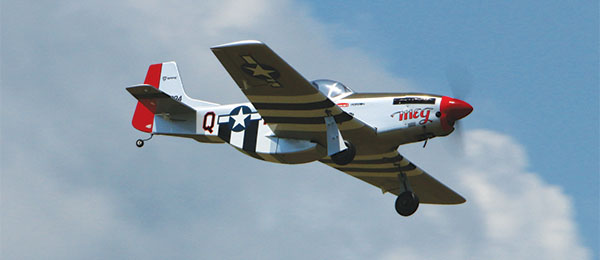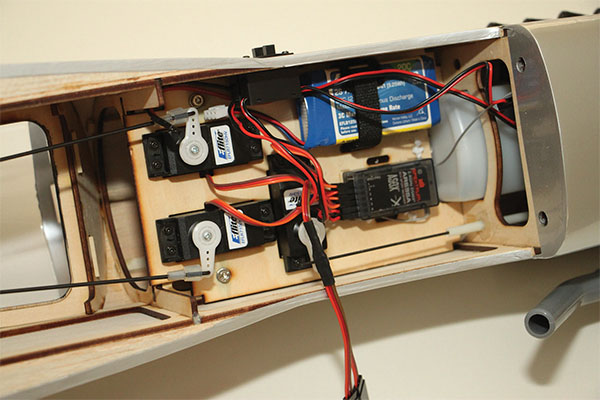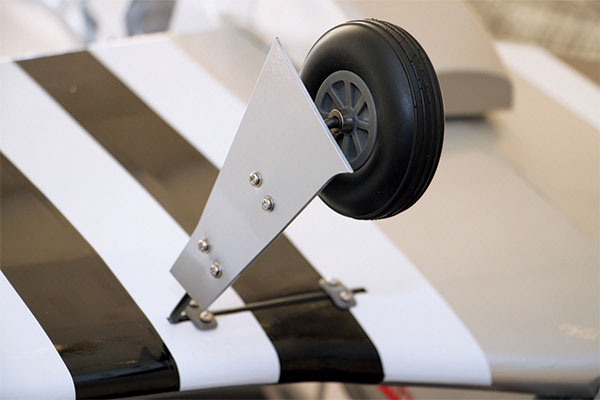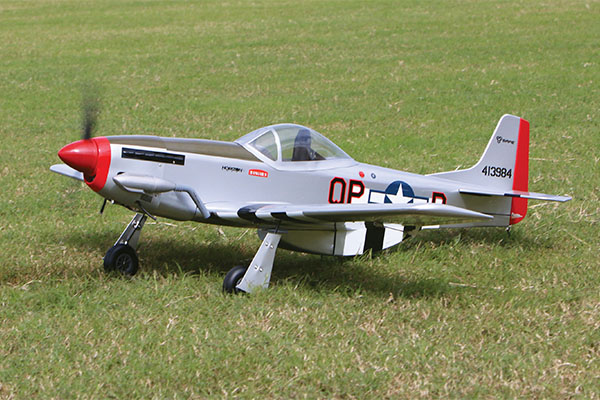Horizon Hobby Hangar 9 P-51 Mustang S 8cc BNF Gas Trainer

Written by Andrew Griffith A gas-powered warbird trainer Abridged product review Photos by Adam Strong Read the full product review in the March 2016 issue of Model Aviation.
Specifications:
• Model type: Semiscale warbird trainer • Skill level: Beginner (with help) to advanced • Wingspan: 54.7 inches • Wing area: 574 square inches • Wing loading: 22 ounces per square foot • Wing cube loading: 11 • Airfoil: Semisymmetrical • Length: 47.7 inches • Weight: 5 pounds, 8 ounces • Engine: Evolution 8cc gas engine (installed) • Radio: Six-channel • Construction: Laser-cut balsa and light plywood • Covering/finish: UltraCote covered in the 334th Fighter Group scheme • Street price: $399.99Test-model Details
• Engine used: Evolution 8cc gas engine (installed) • Receiver battery: E-flite 2S 8.4-volt 1,250 mAh 20C LiPo (installed) • Propeller: 12 x 6 sport • Radio system: Spektrum DX18 G2; four 37-gram E-flite HV Digital servos (installed); AR636 SAFE receiver (installed) • Ready-to-fly weight: 5 pounds, 8 ounces • Flight duration: 20-plus minutesPluses
• Warbird looks with mild-mannered sport airplane flying characteristics. • Preinstalled 8cc Evolution gas engine. • SAFE technology with panic recovery integrated in factory-installed receiver. • Spirted flight performance for experienced pilots. • Wide landing gear stance for excellent ground handling.Minus
• Throttle pushrod needed adjustment.Abridged Product Review
Nary has a month gone by without a first-time RC pilot either asking about learning how to fly a P-51 Mustang or actually showing up at my club field with one, or a similar aircraft, asking for lessons. Disappointment sets in when the pilot realizes that he or she will have to start with a boxy-looking high-wing trainer that he or she will quickly outgrow. A few years ago, Hangar 9 filled a hole in the market by introducing what was known at the time as Progressive Trainer System (PTS) airplanes. The company added high-lift devices to the wingtips, as well as flaps to models such as the F-22 Raptor and the P-51 Mustang. These aircraft allowed a new modeler to get into the air with something sportier, with the help of an instructor. These models could fly slowly and land well, and as a pilot progressed in his or her training, the devices could be removed to make them capable of more spirited performance. When combined with a simulator and a good instructor, the PTS models allowed pilots to fly solo with fighter airplanes, which is what many people envision when they get into RC airplanes. The combination is something often avoided by first-time modelers: a tail-dragger, a fighter airplane, and a gas engine. Much of the work is done for you, and with minimal assembly, you will quickly be at the field with your new Mustang, ready to do some flight training or to escort bombers deep into enemy territory.
The servos, AS3X receiver, battery, and fuel tank are all preinstalled—making the assembly quick.

The simple, durable wire landing gear makes things less complicated for beginners.
Flying
I mixed some ethanol-free gas with Red Line two-stroke oil. The Evolution engine calls for a 20:1 ratio, which is twice what I normally run, and I had to employ a different gas can. The engine refused to fire until the throttle stick was at approximately half throttle, so I performed the fix as detailed in the construction section of this article. When the throttle pushrod was squared away, the engine ran nicely on the bench and didn’t need any tuning. After a few minutes, I headed out for my first flight.Beginner Mode
Despite how aggressively you move the control stick, the airplane will only achieve a bank angle of approximately 25° or so. It will climb slightly, but even at full down-elevator it barely descends unless you chop the throttle. I found it difficult to fly in this mode. The turn radius required to get the Mustang to come back is quite wide. If you let go of the stick, the airplane levels out and does a slight climb. Someone trying to get the hang of the perceived control reversal needs to merely let go and the airplane will right itself until he or she can regain control.Intermediate Mode
This felt more comfortable, and as an instructor, this would likely be the mode in which I would encourage my students to start out flying. Banking is limited to roughly 45° with more elevator authority. It still doesn’t allow inverted flight, but control response felt better and the turn radius was improved. Stabilization, even in the wind, felt good and the SAFE system could inspire confidence in a new pilot.Advanced Mode
Although stabilization is still active in advanced mode, the SAFE system allows the pilot to have full control. Loops, rolls, and inverted flight are all possible. Full-throttle passes are fairly quick and, as a sport airplane, this is a lot of fun. I noticed some oscillation in the ailerons when flying at full speed, which indicates too much gyro gain. I downloaded the AS3X app to my smartphone and ordered a cable to allow me to reduce the gain on each axis. Dropping the gain by 5% on the aileron axis took care of the issue.Panic Recovery
I took the Mustang up high enough that I had enough room for a mistake from the gyro and a mistake by me. The instructions indicate that sufficient altitude is needed to allow the airplane to recover. No matter what attitude I had the Mustang in—upside down, straight up, straight down, or in a spin—as soon as I released the controls and pressed the panic button, the airplane leveled off and started a slight climb. This will give pilots enough time to take a breath if they get in trouble, and allow them to settle down and start flying again. Landing is easily accomplished by using a small amount of power and flying the Mustang until the main wheels touch down. The gyro keeps the airplane steady on final approach, even with some wind.










1 comments
great plane!
Add new comment